Your Solo Home Design: Crafting a Sanctuary for Unrivaled Comfort & Freedom
Solo Home Design: Introduction
Stepping into your own space after a significant life change can feel both daunting and incredibly liberating. It’s an opportunity to reclaim your identity and build a haven that truly reflects you. This guide to solo home design will empower you to transform your apartment for one into a deeply personal sanctuary. Discover how thoughtful single home decor and clever home organization can create a comfortable living space where your rules reign supreme, fostering peace, security, and true enjoyment of solo living.

Reclaiming Your Narrative: The Philosophy of Solo Home Design
After a breakup, your world can feel like it’s been turned upside down, including the very space you call home. For too long, perhaps, your living environment was a negotiation, a compromise reflecting shared lives and dual preferences. But here’s the powerful truth: living solo isn’t a consolation prize; it’s a golden ticket to absolute freedom and self-discovery. This is where the philosophy of solo home design comes in, offering you an unparalleled opportunity to reclaim your narrative and manifest a space that is unapologetically, authentically you. It’s not just about decorating; it’s about deep healing and empowerment, a profound act of self-love that directly impacts your well-being and enjoyment of life. It’s about creating a personal victory lap.Imagine a home where every cushion, every scent, every piece of art resonates with your soul. No more explaining your quirky tastes, no more ceding control over the thermostat, no more compromising on the perfect reading nook because someone else needed a gaming corner. Your solo home becomes a sacred sanctuary, a fortress of comfort and peace, perfectly tailored to your unique rhythm. This personalized environment isn’t just about superficial beauty; it actively contributes to your freedom from fear, pain, and danger by creating a secure, emotionally safe haven. It’s a space that whispers comfort and security, allowing you to truly relax and be yourself without judgment. You are setting new, healthy boundaries for your personal space and mental peace.This journey of solo home design is an assertion of self-worth. You are not just filling a space; you are designing a life. It’s about indulging your desire for comfortable living conditions, cultivating an environment that actively supports your hobbies, encourages your passions, and provides the ultimate backdrop for your personal growth. From a perfectly organized kitchen that makes cooking for one a joy, to a bedroom that feels like a luxurious escape, every decision is a step towards enriching your solo experience and proving to yourself that you are worthy of an extraordinary life. This isn’t just designing a house; it’s designing your future, one where you are the undeniable winner in the narrative of your own happiness.
Key Points
- Solo home design empowers individuals to reclaim their personal narrative and move beyond relationship compromises.
- It transforms a living space into a personalized sanctuary, fostering comfort, peace, and emotional security.
- The process of designing a solo home is a therapeutic act that supports healing, self-love, and psychological well-being.
- Designing for yourself allows for the cultivation of an environment perfectly suited to your hobbies, passions, and personal growth, enhancing overall enjoyment of life.
Practical Insights
- Approach solo home design as an act of self-care and empowerment, making choices that prioritize your authentic self and comfort above all else.
- Consciously create zones within your home that cater specifically to your individual hobbies and passions, making your space a hub for personal enjoyment and growth.
- Embrace the freedom to design without compromise, ensuring every element contributes to a sense of peace, security, and complete alignment with your personal style.
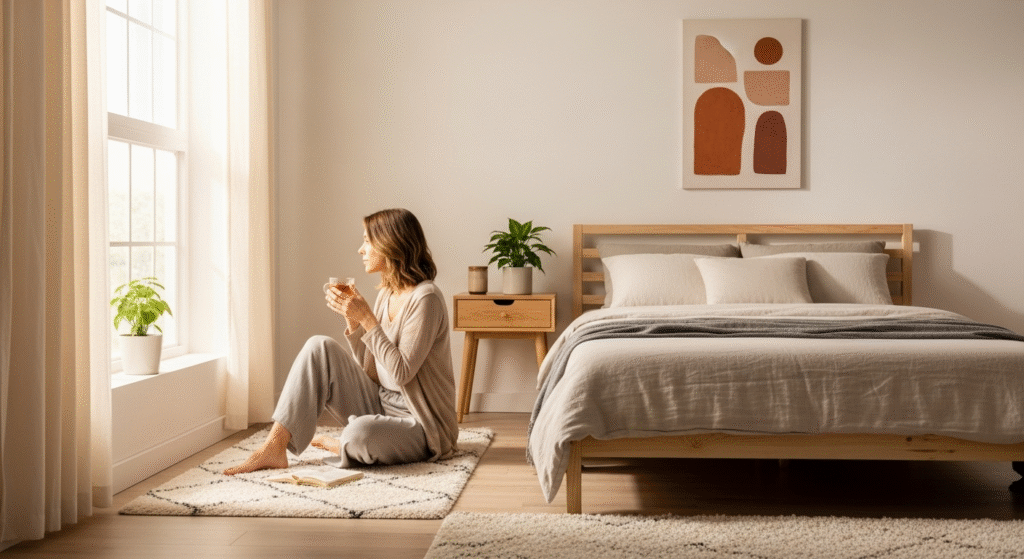
Mastering Small Spaces: Smart Solo Home Design for Function and Flow
After a breakup, your living space isn’t just four walls; it’s your personal fortress, a sanctuary where you can truly enjoy life solo without compromise. For many embarking on this journey of self-discovery, that means navigating a smaller footprint. But don’t let the size of your solo home design dim your vision of ultimate comfort and control. Mastering small spaces isn’t about sacrificing; it’s about smart choices that empower you, creating an environment where every inch reflects your newfound freedom and peace of mind. It’s time to banish the ghosts of shared clutter and design a space that prioritizes your comfort, security, and unique desires.
The secret to a functional and flowing solo home, especially when space is at a premium, lies in intentionality. Think multi-functional furniture – an ottoman that doubles as storage, a dining table that folds away, or a daybed that transforms from sofa to sleep haven. Every piece should earn its keep, enhancing your daily life and contributing to a sense of order and calm. Vertical space is your best friend; floating shelves, tall bookcases, and wall-mounted organizers can free up precious floor area, making your home feel expansive and less confined. This strategic approach ensures you have a place for everything, reducing visual chaos and the mental load of disorganization – a real balm for a recovering heart.
Beyond utility, focus on creating an atmosphere that resonates with your true self. Lighting can dramatically alter a small space, making it feel open and inviting. Layer various light sources – ambient, task, and accent – to create depth and warmth. Choose a cohesive color palette that calms or energizes you, reflecting your personal style rather than someone else’s preferences. This isn’t just about aesthetics; it’s about cultivating comfortable living conditions that support your emotional well-being. By designing a space that flows effortlessly and feels distinctly yours, you’re not just organizing items; you’re orchestrating a symphony of self-care. This dedicated attention to your environment fosters a profound sense of security and belonging, helping you appreciate the difference between loneliness vs solitude and truly embrace your independent journey.
Key Points
- Solo home design in small spaces is an empowering act, prioritizing personal comfort, control, and peace of mind.
- Utilize multi-functional furniture and vertical storage solutions to maximize space and reduce visual clutter.
- Strategic lighting and a personalized color palette are crucial for creating an inviting and emotionally supportive ambiance.
- Designing your solo living space is a profound act of self-care, fostering security and promoting positive solitude.
Practical Insights
- Invest in dual-purpose furniture to optimize every square foot, transforming your living area into a versatile sanctuary that reduces stress and enhances convenience.
- Embrace vertical storage solutions like floating shelves or tall bookcases to clear floor space, promoting a feeling of openness, order, and mental clarity.
- Curate your space with personal touches and thoughtful layered lighting to ensure it feels like a comforting retreat, dedicated solely to your peace, enjoyment, and emotional well-being.
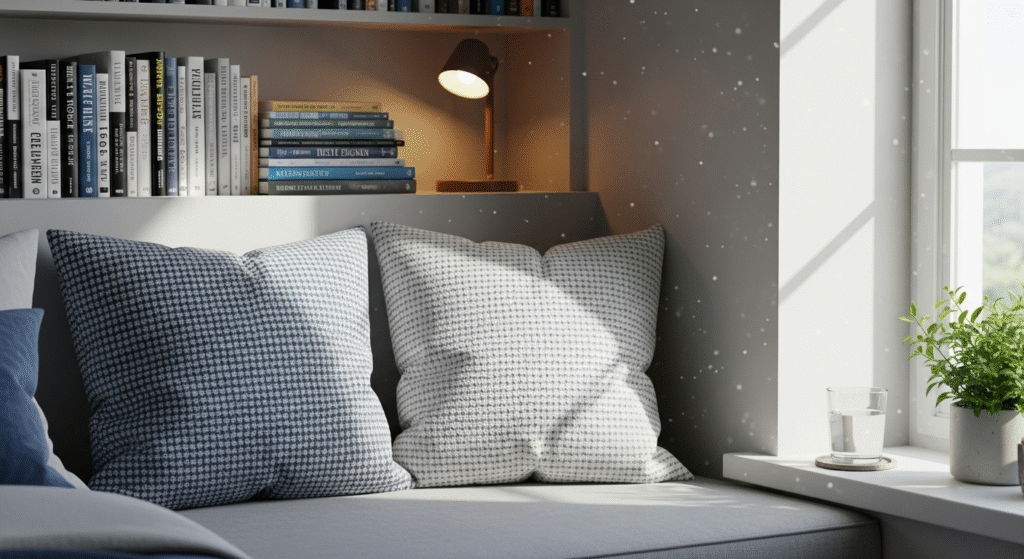
Personalizing Your Haven: Infusing Your Identity into Your Solo Living Space
The aftermath of a significant relationship can often leave us feeling a little lost, like our identity became intertwined with another’s. But here’s the empowering truth: your solo living space is an untouched canvas, a sacred territory awaiting the vibrant strokes of *your* authentic self. This isn’t merely about interior decoration; it’s a profound act of self-reclamation. Imagine stepping into a home that unequivocally breathes *you* – where every deliberate color choice, every chosen piece of art, and every functional item is a testament to who you are and what genuinely brings you joy. This intentional “solo home design” transcends the superficial; it’s a powerful statement of self-worth and empowerment, creating comfortable living conditions tailored precisely to your needs.Consider the profound comfort and deep peace you deserve. By meticulously surrounding yourself with objects and aesthetics that truly resonate, you actively construct a fortress of solace, offering freedom from fear, pain, and danger and embracing unapologetic joy. The days of compromising on throw pillows, wall art, or even the style of your furniture are over. This is your unparalleled opportunity to curate an environment that not only reflects but actively supports your healing journey and fosters significant personal growth. Your home transforms into a constant, tangible affirmation of your inherent strength and unwavering resilience.What genuinely ignites your enjoyment and sense of vitality? Is it a lively gallery wall showcasing rediscovered passions, or a minimalist sanctuary designed to promote profound calm? Perhaps it’s a cozy reading nook overflowing with the books you adore, or a dedicated corner for a new hobby you’re enthusiastically rediscovering or exploring, like painting, playing an instrument, or practicing yoga. Every single decision, regardless of its perceived size, contributes significantly to crafting a living situation that doesn’t just feel like a house, but a true haven. This deeply personal process is vital for rebuilding self-esteem and fostering social approval within yourself. When your physical environment mirrors your authentic self, it powerfully reinforces your intrinsic worth and validates your unique individuality. It ceases to be about impressing external observers; it becomes entirely about profoundly impressing *yourself* with the beautiful, distinctive world you’ve meticulously brought to life. This personalized haven cultivates not just superior, comfortable living conditions, but a deep, abiding sense of peace and belonging within your own skin, ensuring your space is a pure reflection of your most authentic, empowered self.
Key Points
- Solo living presents a unique opportunity to design a home that is a pure reflection of your authentic identity, free from the need for compromise.
- The act of personalizing your space is a powerful form of self-reclamation, fostering comfort, peace, and empowerment as you heal and grow.
- Intentional “solo home design” helps create a personal sanctuary that actively supports your emotional well-being and personal development.
- Surrounding yourself with objects and aesthetics that deeply resonate reinforces your self-worth and validates your unique individuality.
- This personalization process cultivates a profound sense of belonging and peace within your own home, making it a true haven for your spirit.
Practical Insights
- Start with one room: Choose a space you use most often, like your bedroom or living area, and focus on infusing it with elements that bring you immediate joy and comfort.
- Declutter with intention: Remove items that remind you of past relationships or no longer align with your current self, making room for décor that celebrates your new identity and aspirations.
- Embrace your passions: Dedicate a specific area or integrate décor that highlights your hobbies, interests, or new aspirations, transforming your home into a dynamic reflection of your evolving self.
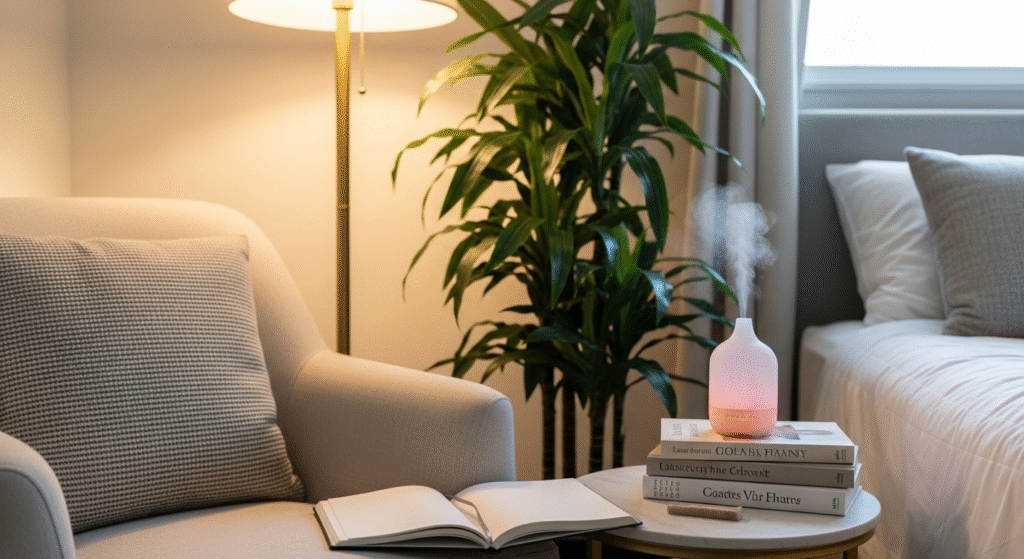
Creating Sanctuary: Emotional Well-being Through Solo Home Design Choices
After a breakup, your home isn’t just four walls and a roof; it’s a profound extension of your inner world, a canvas awaiting your true self. For those navigating the path of solo living, especially after disentangling from a shared life, the opportunity for solo home design becomes a powerful act of reclaiming your narrative. This isn’t just about aesthetics; it’s about crafting a sanctuary that nurtures your emotional well-being, providing a deep sense of security and peace of mind you may not have realized you were missing. Think of your space as your personal fortress, designed solely by *your* rules. Every choice, from the paint on the walls to the texture of your throw pillows, should resonate with your authentic desires, free from compromise or past influences. This deliberate act of designing for one actively supports your healing journey, transforming your living environment into a supportive partner rather than a reminder of what was. It’s an investment in your comfortable living conditions and, more importantly, in your sustained happiness.Embrace personalization. Perhaps you’ve always yearned for a vibrant reading nook bathed in natural light, or a minimalist bedroom that exudes calm. Now is your chance. Consider how colors affect your mood – soft blues and greens can promote tranquility, while warm yellows might spark joy. Decluttering isn’t just tidying; it’s a symbolic release, creating mental space and physical order that contribute immensely to feelings of stability and control. This intentional approach to solo home design helps to boost mental health by aligning your environment with your internal state.Furthermore, dedicating specific zones within your home can amplify its sanctuary-like qualities. A cozy corner for reflection, a vibrant area for creative pursuits, or a simple space for quiet meditation. These designated areas reinforce your personal boundaries and validate your need for solitude, transforming potential loneliness into profound self-connection. It’s about understanding the distinction between loneliness and solitude and actively choosing to cultivate the latter. Your solo home design choices are more than just decorating; they are foundational steps in rebuilding self-esteem, asserting independence, and creating an unshakeable sense of peace that permeates every aspect of your new, empowered life. This isn’t just a home; it’s your personal statement of strength and self-love.
Key Points
- Solo home design after a breakup is a powerful act of reclaiming personal narrative and nurturing emotional well-being.
- Designing your space based solely on your desires creates comfortable living conditions and contributes to sustained happiness, free from past influences.
- Intentional choices like color psychology, decluttering, and creating order foster mental clarity, stability, and control, significantly boosting mental health.
- Dedicated zones within your home reinforce personal boundaries and transform potential loneliness into profound self-connection and valued solitude.
- The process of solo home design builds self-esteem, asserts independence, and cultivates an unshakeable sense of peace in your empowered life.
Practical Insights
- Prioritize your personal comfort and joy in every design choice, ensuring your space reflects your authentic self and contributes to your peace of mind.
- Create dedicated ‘zones’ within your home for different emotional needs, such as a calming relaxation nook or an inspiring creative corner, to actively support your healing.
- Mindfully declutter and organize your space, removing items that no longer serve you, to foster mental clarity and a sense of stability in your new solo chapter.
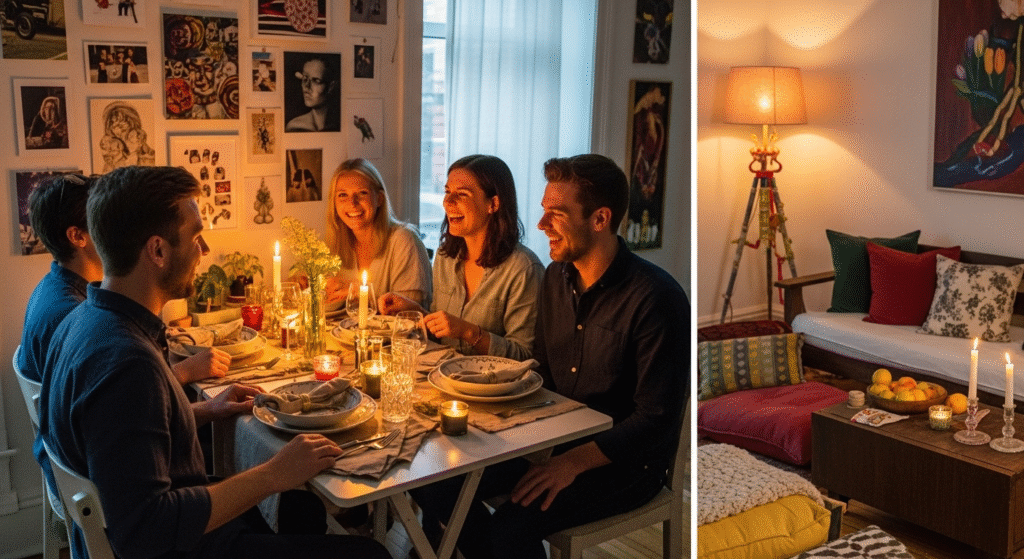
Entertaining (Yourself and Others): Adapting Your Solo Home Design for Social Connection
Your solo home, after a significant life shift like a breakup, becomes more than just walls and a roof; it’s a sanctuary, a statement of your newfound independence. But true liberation isn’t about isolating yourself; it’s about confidently choosing when and how you connect. Designing your solo home for social connection isn’t about sacrificing your personal haven, but about creating a flexible, welcoming environment where you can entertain yourself with blissful solitude or open your doors to those who matter most. This approach ensures your space supports your healing and growth, preventing the isolation that can hinder your progress and reinforcing your enjoyment of life on your own terms.
The key to a truly inviting solo home design is adaptability. Think multi-functional spaces that effortlessly transition from your private retreat to a vibrant social hub. Your living room, for instance, can be a quiet reading nook by day and transform into a cozy gathering spot for friends by night. This thoughtful design provides a powerful sense of ‘comfortable living conditions’ for you while also showcasing your readiness for connection, subtly boosting your ‘social approval’ among your circle. Consider versatile furniture like nesting tables, modular seating, or even a chic floor pillow collection that allows for flexible arrangements without cluttering your space. It signals to guests that you’re prepared to welcome them, fostering a sense of ease and belonging without compromising your personal serenity.
Don’t shy away from creating designated zones for connection. A well-placed bar cart, a cozy dining nook, or even just ample, comfortable seating arrangements can dramatically change the feel of your home when company arrives. The goal is to make entertaining feel effortless, not an obligation. By simplifying the process, you reduce any underlying ‘fear or pain’ associated with hosting, making it a source of genuine ‘enjoyment of life’. Remember, your solo home design isn’t about performing; it’s about authentically expressing your desire for connection while honoring your need for personal space. It’s about being confident enough to host, which is a huge step in rebuilding your social confidence. Embrace the idea that your home can be a hub for enriching interactions, whether it’s a deep conversation over coffee or a lively game night. Mastering this balance is crucial for your overall well-being, allowing you to flourish both independently and within your chosen community, finding your sweet spot in balancing alone time and socializing.
Key Points
- A solo home should be designed to support both personal sanctuary and confident social connection, preventing isolation and fostering growth.
- Adaptability is key in solo home design, utilizing multi-functional spaces and versatile furniture to transition between private and social modes seamlessly.
- Creating designated zones for entertaining, such as a cozy dining nook or ample seating, makes hosting effortless and reduces anxiety.
- Authenticity in solo home design means expressing a desire for connection while consistently honoring the need for personal space and comfort.
- Thoughtful home design contributes to overall well-being by empowering individuals to confidently balance solitude with enriching social interactions.
Practical Insights
- Invest in versatile, movable furniture pieces that allow you to quickly reconfigure your space for different social scenarios, enhancing comfort for both you and your guests and boosting your hosting confidence.
- Designate a ‘hosting zone’ within your home, such as a small bar cart or an easily accessible serving area, to minimize stress when guests arrive, freeing you to genuinely enjoy the company.
- Prioritize comfortable, ample seating to encourage lingering and deep conversations, signaling genuine hospitality and reinforcing your desire for meaningful social connections without sacrificing your personal aesthetic.
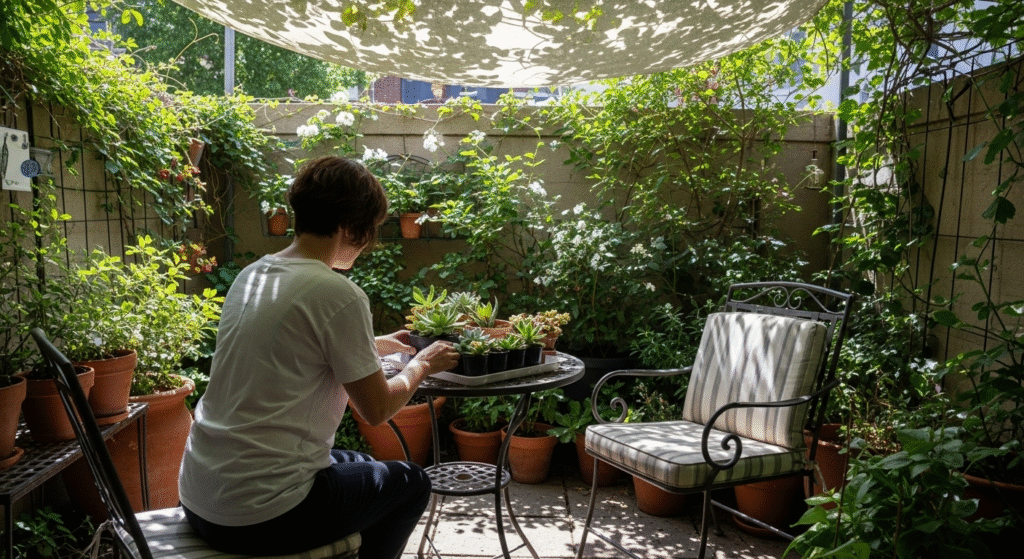
Sustainable Solo Home Design: Building a Future-Forward Personal Space
After a significant life change, your home isn’t just a place to live; it’s a sanctuary, a canvas for your future, and a testament to your newfound independence. When it comes to “solo home design”, embracing sustainability isn’t just a trend; it’s a profound investment in your personal well-being, long-term security, and the planet. Building a future-forward personal space means creating an environment that nurtures you, reduces your stress, and empowers you to thrive without relying on external validation or unsustainable habits. Imagine a home where every element contributes to your peace of mind and comfort. Sustainable solo home design is about intelligent choices that protect your resources and extend your enjoyment of life. Think about energy-efficient appliances and smart thermostats that keep utility bills low, freeing up your finances for experiences that truly matter. This isn’t just about saving money; it’s about establishing freedom from financial fear and gaining a sense of control over your destiny. It’s about building a foundation of stability that’s entirely your own.Beyond the financial, consider the psychological benefits. Natural, non-toxic materials contribute to cleaner indoor air, boosting your health and vitality. Thoughtful design that maximizes natural light reduces the need for artificial lighting, enhancing your mood and connecting you to the rhythms of the day. This attention to detail isn’t about extravagance; it’s about crafting comfortable living conditions that actively support your physical and mental health. Designing a space that truly reflects your values and protects your peace is a powerful act of setting healthy boundaries for yourself, ensuring your solo sanctuary is resilient and self-sustaining.By choosing durable, long-lasting materials, you’re not just making an eco-conscious decision; you’re building a home that requires less maintenance, giving you more time to pursue your passions and enjoy your solitude. This sense of self-sufficiency and a reduced environmental footprint can offer a deep sense of accomplishment and contribute to your feeling of being a responsible, capable individual charting their own course. Your sustainable solo home becomes a quiet statement of strength, a space where you are truly in charge of your comfort and your future.
Key Points
- Sustainable solo home design is a vital investment in personal well-being, long-term security, and future resilience.
- Energy-efficient choices reduce utility bills, fostering financial freedom and a sense of stability.
- Utilizing natural, non-toxic materials improves indoor air quality, boosting health and vitality in your personal space.
- Thoughtful design that maximizes natural light enhances mood and reduces reliance on artificial energy.
- Opting for durable, low-maintenance materials frees up time, promotes self-sufficiency, and builds a lasting sanctuary.
Practical Insights
- Start by integrating energy-efficient appliances or smart home devices to immediately reduce costs and establish greater financial security in your solo living.
- Prioritize natural light and non-toxic materials in your interior design to create a healthier, more comfortable environment that actively boosts your mood and overall vitality.
- Invest in high-quality, durable furnishings and finishes; this not only benefits the environment but also provides peace of mind through reduced maintenance and a stable, long-lasting personal sanctuary.
Conclusion
Embracing solo living means more than just having a place to sleep; it’s an opportunity to sculpt a space that wholly supports your well-being and personal growth. By prioritizing your comfort, curating elements that reflect your true self, and implementing smart solo home design principles, you can transform any space into an empowering sanctuary. This isn’t just a house; it’s your home, a testament to your resilience and a daily reminder that your rules create your ultimate comfort and peace.